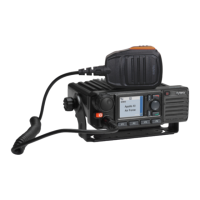–
will become low, and no power will be output from PA. Otherwise, PA will work normally.
5.3.2 Receiver Circuit
The receiver circuit employs double conversion superheterodyne technique. The first IF is 44.85 MHz
and the second IF is 2.25 MHz. The first local oscillator (LO) signal is supplied by the PLL circuit (U100),
and the second LO signal (47.1 MHz) is supplied by IF processor circuit (U701). The major units are BPF
and LNA, mixer, IF filter, IF amplifier, and IF processor.
ANT
Low Noise Amp
Q6102
Mixer
D6106
LPF
1 2
Attenuator
3dB
1 2
Q6103
IF Filter
Z6100
IF Amp
Q6104
Q6105
U701
IF IC
IF Processor
U302
OMAP
19.2MHz
18M
47.1M
RX_LO:
91.15-129.15MHz
TV
Attenuator
1dB
Attenuator Control
10dB
Tx/Rx Switch
Low-pass Filter
Receiver Front-end
RF signals feed to the low-pass filter to remove out-of-band signals, and are applied to the two-stage
electrically tunable band-pass filter to get useful signals. After passing through the RF band-pass filter
and LNA (Q6102), the RF signals together with the first LO signal feed to the mixer (D6106) for the first
frequency conversion, to generate the first IF signal (44.85 MHz). The LO signal (3-5 dBm) from the
VCO feeds to Q6103 to get a gain of 17 dB, meeting the mixer’s requirement. The first LO signals (44.85
MHz) pass through the crystal filter (Z6100) to remove out-of-band spurious signals, and then feed to the
two-stage IF amplifier circuit (composed of Q6105 and Q6104) for amplification. Finally the amplified
signals go to the IF IC for digital processing.
Receiver Back-end

